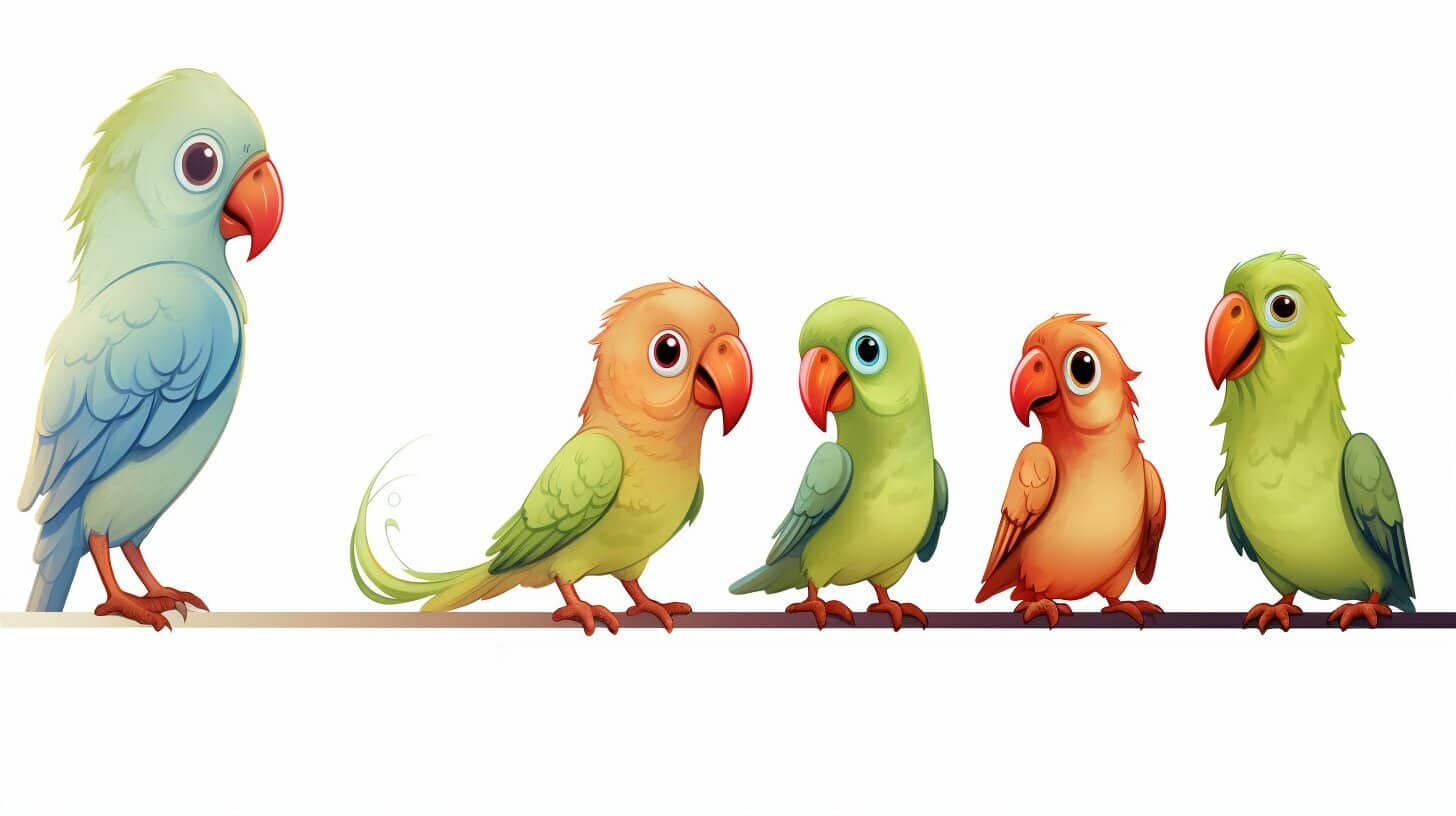Kakarikis are lively, colourful parakeets that have captured the hearts of bird enthusiasts worldwide. As with all living creatures, understanding these charming birds’ growth and development stages is crucial to ensuring their well-being. In this article, we will explore Kakarikis’s growth and development stages, providing you with the insights you need to help them thrive.
Have you ever wondered what age are Kakarikis fully grown? Or how long it takes for them to grow to their full size? We’ve got you covered. Let us dive into the fascinating world of Kakariki’s development stages and timelines.
Key Takeaways:
- Kakarikis are captivating bird species native to New Zealand
- Understanding their growth and development stages is essential for their well-being
- In this article, we will explore the growth timeline of Kakarikis and the age at which they reach full maturity
Kakariki Development Stages: From Hatchling to Adulthood
Kakarikis go through various developmental stages from hatchling to adulthood, with each stage presenting unique physical and behavioural changes. Understanding these phases is crucial to providing optimal care for them. Here, we will discuss each stage of Kakariki development, starting from when they hatch to when they reach adulthood.
| Development Stage | Description | Duration |
|---|---|---|
| Hatchling Stage | Kakarikis are born blind, naked, and entirely dependent on their parents for food and warmth. During this stage, they undergo rapid physical development, growing from a hatchling to a juvenile bird. | 0-3 weeks |
| Juvenile Stage | Kakarikis start to gain independence during this stage, weaning off their parents and learning to feed themselves. They also develop their flying and perching abilities. | 3 weeks – 6 months |
| Adulthood | Kakarikis reach sexual maturity during this stage and reach their maximum size. Their plumage also reaches its full colouration. | 6 months – 1 year |
The hatchling stage lasts about 0-3 weeks, during which Kakarikis undergo rapid physical development. As they grow, their feathers start to emerge, and they start to open their eyes. They learn to stand and walk, progressively gaining strength in their legs.
Once they become juveniles, they start to wean off their parents and learn to feed themselves. They spend more time outside the nest and develop their flying and perching abilities. Juvenile Kakarikis are energetic, and their playful and curious nature reflects their ongoing development.
Kakarikis reach adulthood at around six months to a year. Their growth rate slows during this stage, and they attain their maximum size and weight. They also reach sexual maturity, and their plumage attains its full colouration, which is vibrant and striking.
Early Growth: The Hatchling Stage
The hatchling stage is the first and most critical stage of Kakariki development.
During this stage, the Kakariki is vulnerable and requires extra care and attention from its carer. At this stage, the Kakariki is fragile, approximately 1-2 inches long, and weighs between 6-8 grams. It is blind, naked, and entirely dependent on its carer for warmth, food, and protection from predators.
Within a week, the Kakariki opens its eyes and grows feathers. It will also start to move around the nest and explore its surroundings, demonstrating increased coordination and motor skills. By the end of the third week, the Kakariki will have grown its feathers and started to fly short distances.
The hatchling stage lasts up to six weeks, and during this period, it is crucial to provide proper nutrition, warmth, and a clean environment. A diet rich in protein, vitamins, and minerals is essential for the Kakariki’s growth and development. It is recommended to feed them a mix of high-quality commercial bird food supplemented with fresh fruits and vegetables.
In addition to nutrition, it is important to create a warm and safe environment for the hatchling, free from predators and with adequate perches and nesting material. Interacting with the hatchling and handling it gently can help socialise it and build a strong bond with its carer, leading to a happier and healthier Kakariki.
Overall, the hatchling stage is a crucial period in a Kakariki’s life; proper care and attention during this stage can help ensure a healthy and robust bird.
Juvenile Stage: Kakarikis on the Path to Adulthood
As Kakarikis transition from hatchlings to adults, they enter the juvenile stage, which typically lasts from three months to one year. During this period, Kakarikis undergo significant physical and behavioural changes as they continue to grow and develop.
One of the most noticeable changes during this stage is the development of their distinctive plumage, with its vibrant mix of greens, yellows, and reds. Their wings also form fully, enabling them to fly and explore their environment more extensively. Juvenile Kakarikis also begin to display their unique personalities, with some becoming more boisterous and outgoing while others remain shy and reserved.
It’s crucial to provide Kakarikis with ample opportunities to exercise and explore their surroundings during this stage. For instance, you can offer them a variety of toys, perches, and climbing structures to keep them engaged and active. Additionally, providing diverse foods is important to support their growth and development.
As they approach adulthood, ensure their living conditions are suitable for a fully grown Kakariki to prevent any issues. This includes providing enough space, proper lighting, and suitable nesting options. By providing ideal conditions and plenty of socialisation, your Kakariki can thrive as it enters the final stages of development.
Reaching Adulthood: When Kakarikis Stop Growing
After successfully passing through the hatchling and juvenile stages, Kakarikis reach adulthood. Typically, these birds reach maturity between 1-2 years of age. During this stage, their growth rate slows significantly, and they reach adulthood.
The adult size of Kakarikis varies depending on the species. Red-crowned Kakarikis can reach a length of up to 30cm, while Yellow-crowned Kakarikis are slightly smaller, reaching a length of around 25cm. Kakarikis’ weight at this stage ranges from 90-120g.
It’s essential to note that while Kakarikis stop growing during adulthood, their nutritional and environmental needs remain critical. Proper care is necessary to maintain their health and well-being.
Providing Optimal Care at Each Stage
As Kakarikis go through their various developmental stages, they have different needs and requirements. Providing the best care for them at each stage is crucial to their development and well-being. Here are some tips on how to provide optimal care for your Kakarikis:
1. Hatchling Stage
During the hatchling stage, your Kakarikis will require frequent feedings of a specialised formula. Keeping their environment warm and clean is essential, as their immune system is weak during this stage. Provide a nesting box with a soft lining for them to rest in, and avoid handling them too much to reduce stress.
2. Juvenile Stage
As your Kakarikis grow and become more active, they will require more space to move around. Provide a spacious cage with plenty of toys and perches for them to explore and play with. Ensure they have access to fresh food and water at all times, including various fruits and vegetables to supplement their diet.
3. Adult Stage
When your Kakarikis reach adulthood, they will require a balanced diet to maintain their health. Continue to provide fresh food and water, and supplement their diet with seeds, pellets, and other nutrient-rich foods. Ensure they have plenty of space to move around and offer them toys and activities to prevent boredom.
In addition to these tips, it is essential to monitor your Kakariki’s behaviour and health regularly. Take them to the vet for check-ups and vaccinations, and seek medical attention immediately if you notice any unusual behaviour or symptoms.
Conclusion
Understanding Kakarikis’ growth and development stages is crucial to providing appropriate care for these fascinating birds. From their hatchling stage to adulthood, Kakarikis undergo various physical and behavioural changes that require specific attention.
As we have explored, Kakariki development stages include hatchling, juvenile, and adulthood, each requiring different care and attention. It’s essential to give them the appropriate nutrition, habitat, and socialisation they need to thrive.
By providing optimal care at every stage, we can ensure our Kakarikis’ overall health and happiness. It’s a rewarding experience to watch these birds grow and develop into healthy, well-adjusted adults.
Learn More About Kakarikis
Want to learn more about Kakarikis and how to care for them? Watch for more of our articles on this fascinating bird species. We’re dedicated to providing you with helpful and informative content to help you become the best Kakariki parent possible.
FAQ:
Q: At what age are Kakarikis fully grown?
A: Kakarikis reach full maturity at around 1 to 1.5 years of age.
Q: What are the development stages of Kakarikis?
A: Kakarikis undergo three main development stages: hatchling, juvenile, and adulthood.
Q: How long does it take for Kakarikis to reach their full size?
A: It takes approximately 6 to 8 months for Kakarikis to reach their full size.
Q: When do Kakarikis stop growing?
A: Kakarikis generally stop growing after reaching their full size at around 6 to 8 months of age.
Q: What happens during the hatchling stage?
A: The hatchling stage is the early growth phase of Kakarikis, where they undergo physical and behavioural changes.
Q: What milestones occur during the juvenile stage?
A: The juvenile stage is a transitional phase for Kakarikis, where they progress from hatchlings to young adults, acquiring new abilities and characteristics.
Q: When do Kakarikis reach adulthood?
A: Kakarikis typically reach adulthood at around 1 to 1.5 years of age.
Q: How can I provide optimal care for Kakarikis at each stage?
A: To provide the best care for Kakarikis at each stage, ensure they have a balanced diet, a suitable habitat, opportunities for socialisation, and other essential factors for their well-being.



Have comments or questions about this article? Then get involved!
Spotted an error or something we have missed? Let us know